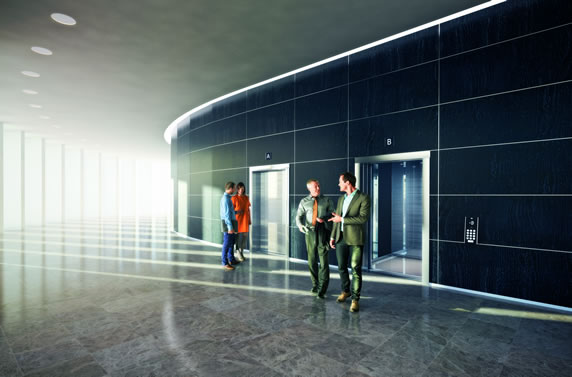
Some destination control technology allows architects and building owners more freedom with the design of the lobby and elevator car locations. Elevators don’t need to be positioned in a clearly visible row, which makes it possible to attach or detach additional elevators to existing groups and place elevators farther apart, around corners, etc.
Wouldn’t it be nice if your building’s tenants and guests enjoyed more orderly lobbies, faster and less-crowded elevator rides, and increased security?
Elevators move 10 billion people each week; as high-rise facility managers and owners can attest, tenants and guests traveling to the highest floors of a building often experience crowded elevators that make several painstaking stops at multiple floors before reaching the highest destinations. This all-too-common situation is a result of traditional elevator systems where passengers can only select their vertical direction: up or down.
Destination control systems (DCSs) allow elevator passengers to select the specific floor they’re traveling to rather than selecting only “up†or “down.†The DCS then groups passengers traveling to the same (or nearby) floors and directs each passenger to the correct elevator.
The result? Increased efficiency that benefits building owners, managers, and guests by providing improved system performance, enhanced customer experience, and heightened security.
Improve System Performance
By looking at information beyond the passenger’s desired direction, destination control systems have the unique ability to adapt to changing traffic conditions. The resulting increase in elevators’ handling capacities is especially noticeable during intense traffic periods like the morning up-peaks common in office buildings.
Destination control systems can further optimize system performance with artificial intelligence that is capable of learning and forecasting the traffic flows of a building. When the traffic intensity alters, the control system measures the changed traffic patterns and switches its optimization routines accordingly.
Enhance Tenant Experiences
Any time elevator efficiency increases, customer experience is enhanced; however, the unique benefits of destination control systems increase passenger comfort from floor selection to destination arrival.
While conventional control systems promote crowded lobbies with passengers rushing to the first car that arrives, destination control technology encourages organization and orderly boarding through intelligent matching of elevators and passengers. Furthermore, because passengers select their destination before entering the elevator, they avoid the hassle of crowded in-car operating panels. Instead, buttons are used to indicate on which floors the elevator will stop, and when customers have reached their destination.
And because each elevator car serves only a specific range of floors, the journey time for tenants and guests will be short with fewer intermediate stops.
Heighten Security
Facility managers can also integrate destination control systems into access control systems. Occupants can use swipe cards and PIN codes to restrict unauthorized use of elevators and add to the security of the entire building.
For the building operator, this means minimized interfaces. For building tenants, this means increased protection from unauthorized occupancy by using key cards and PIN codes to prohibit wandering guests from entering floors they shouldn’t be on.
In addition, for people who need more time and space, an accessibility function can be activated with a card reader or a special button. This gives the tenant or guest more time to reach the elevator car, longer door dwell times, and more available space because fewer people are assigned to that particular elevator car.
Although this technology has been around since 1990, the technology is becoming more and more common in modernization and new construction projects. There are new modernization interfaces that are compatible with both old and new elevator systems, making it easier to eliminate decreases in handling capacity during modernization projects. During elevator modernization projects, both old and new elevator groups can operate in the same lobby area while eliminating capacity decrease during the project.
Because of destination control technology’s ability to intelligently group passengers, both facilities managers and tenants can enjoy dramatically improved efficiency and flow.
Image courtesy of KONE
Kellie Lindquist
Kellie Lindquist, LEED Green Associate, is marketing manager at Lisle, IL-based KONE.

